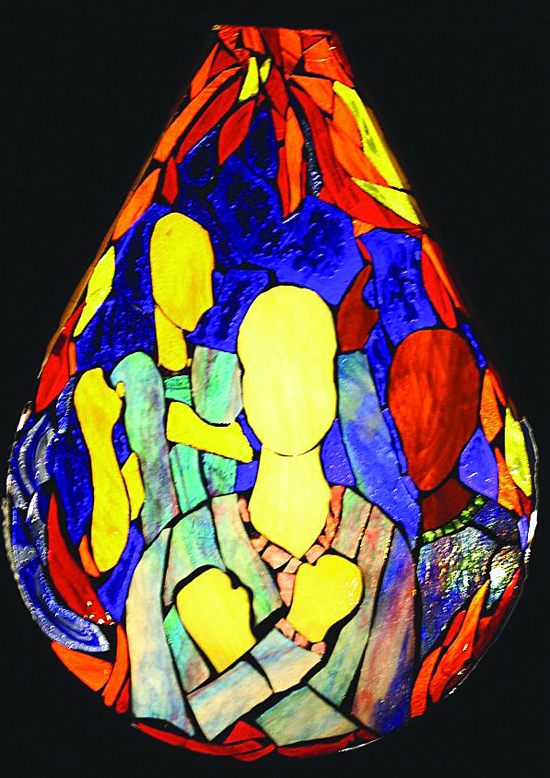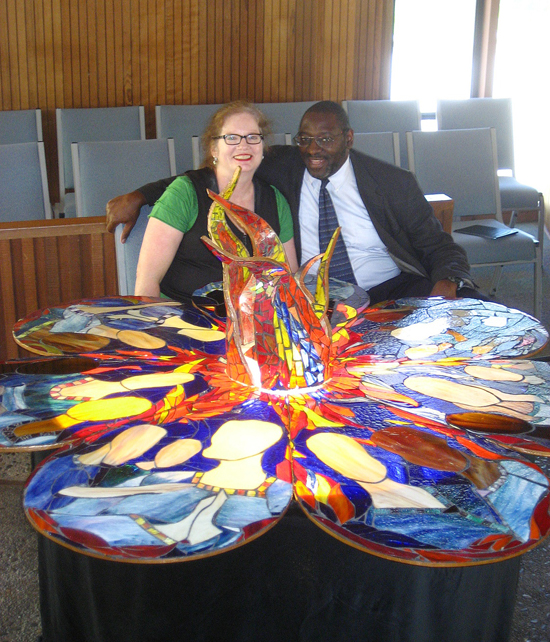| | Published March 27th, 2013
| "Table of Tears" Mosaic Brings the Marginalized into Focus
| | By Lou Fancher |  | | One of seven teardrops that together form the "Table of Tears."
Photo Donna Fado Ivery
|
If there's an icon representing the storied life of visual artist Donna Fado Ivery, it would be made of glass.
 In 1994, the former United Methodist minister was seated with her family in front of a 200-pound window affording a spectacular view of Lake Tahoe. Ivery and her husband, Hubert, were treating his parents, visiting from the deep South, to a $5.99 prime rib dinner and their first-ever sighting of snow. Their two children, Aisha and Imani, both under the age of five, were at the table, where water glasses had been filled while they prepared to order.
In 1994, the former United Methodist minister was seated with her family in front of a 200-pound window affording a spectacular view of Lake Tahoe. Ivery and her husband, Hubert, were treating his parents, visiting from the deep South, to a $5.99 prime rib dinner and their first-ever sighting of snow. Their two children, Aisha and Imani, both under the age of five, were at the table, where water glasses had been filled while they prepared to order.
 "I can still see the scattered ice cubes and shards of glass," Ivery says, remembering in an interview the moment after the too-small screws at the top of the window frame sprung free, releasing the window.
"I can still see the scattered ice cubes and shards of glass," Ivery says, remembering in an interview the moment after the too-small screws at the top of the window frame sprung free, releasing the window.
 Ivery's head was crushed, pinned to the table, until her husband managed to haul the massive, injurious panel away. But the devastating contrecoup (multiple) concussion was less easily removed.
Ivery's head was crushed, pinned to the table, until her husband managed to haul the massive, injurious panel away. But the devastating contrecoup (multiple) concussion was less easily removed.
 Almost 20 years later, she is transforming the shattered pieces of her existence with art.
Almost 20 years later, she is transforming the shattered pieces of her existence with art.
 And in a four year project, inspired by watching mosaicist Jim Wright lead a glass-cutting workshop with children, Ivery has crafted a light-filled, love-laden vessel where the broken become whole.
And in a four year project, inspired by watching mosaicist Jim Wright lead a glass-cutting workshop with children, Ivery has crafted a light-filled, love-laden vessel where the broken become whole.
 Her "Table of Tears," a six-foot diameter stained glass mosaic art piece, is on display through Easter at Orinda's St. Mark's United Methodist Church. A stunning, organic, and profound frontispiece, the table is serving as the cornerstone for a series of sermons titled, "Healing the Tears that Bind Us."
Her "Table of Tears," a six-foot diameter stained glass mosaic art piece, is on display through Easter at Orinda's St. Mark's United Methodist Church. A stunning, organic, and profound frontispiece, the table is serving as the cornerstone for a series of sermons titled, "Healing the Tears that Bind Us."
 There are no sharp corners on the table, where a central sculpture lifts curved, wave-like shards of orange, red and yellow glass vertically, resembling flames. Instead, the seven lobes-shaped like tears, or flower petals-inscribe a gentle circular form. In each tear, Ivery has placed faces representative of a people or group she says Christian theology has historically deemed substandard.
There are no sharp corners on the table, where a central sculpture lifts curved, wave-like shards of orange, red and yellow glass vertically, resembling flames. Instead, the seven lobes-shaped like tears, or flower petals-inscribe a gentle circular form. In each tear, Ivery has placed faces representative of a people or group she says Christian theology has historically deemed substandard.
 Using the Bible to exclude the deaf, African Americans, those with mental illness, the GLBT, the left-handed, women, and to excuse having sent the Japanese to internment camps, she says, is "intolerable."
Using the Bible to exclude the deaf, African Americans, those with mental illness, the GLBT, the left-handed, women, and to excuse having sent the Japanese to internment camps, she says, is "intolerable."
 Division, when people "grab sides and refuse to cross over," must be countered with active voices, she suggests.
Division, when people "grab sides and refuse to cross over," must be countered with active voices, she suggests.
 "And the Holy Spirit is the centerpiece. Without it, the whole table would crash. Look and learn: God is a part of the drama pulling us all together," she says.
"And the Holy Spirit is the centerpiece. Without it, the whole table would crash. Look and learn: God is a part of the drama pulling us all together," she says.
 Coming from the words of a charlatan, this is deception. Coming from the mouth of a woman who spent five years in rehabilitation and 16 years seeking relief for double vision, chronic head pain, balance issues, uncontrollable tremors, and the inability to read more than one magazine article per week, it's miraculous.
Coming from the words of a charlatan, this is deception. Coming from the mouth of a woman who spent five years in rehabilitation and 16 years seeking relief for double vision, chronic head pain, balance issues, uncontrollable tremors, and the inability to read more than one magazine article per week, it's miraculous.
 "Painting saved me. I couldn't speak, but I could paint my pain," she says. "I could say 'Here is what is in my way' with color. In every painting, I expressed honesty."
"Painting saved me. I couldn't speak, but I could paint my pain," she says. "I could say 'Here is what is in my way' with color. In every painting, I expressed honesty."
 And after each encounter with oil and canvas, Ivery moved one step closer to healing. Not healing for her brain-which remains wracked with pain and a fatigue that, by afternoon, often leaves her incoherent-but reparation of her soul leading her to a gracious, compassionate outlook.
And after each encounter with oil and canvas, Ivery moved one step closer to healing. Not healing for her brain-which remains wracked with pain and a fatigue that, by afternoon, often leaves her incoherent-but reparation of her soul leading her to a gracious, compassionate outlook.
 "I can appear completely normal...for about two hours," she laughs. "But seriously, I had a dramatic healing two years ago and could finally get off pharmaceuticals and walk without a cane. I did brain surgery with the angels. It was amazing."
"I can appear completely normal...for about two hours," she laughs. "But seriously, I had a dramatic healing two years ago and could finally get off pharmaceuticals and walk without a cane. I did brain surgery with the angels. It was amazing."
 She recognizes the humor in her description, but speaks sincerely.
She recognizes the humor in her description, but speaks sincerely.
 Because she can no longer stand in front of a congregation and preach messages of grace for the marginalized, Ivery has established Spirit Brush Arts, a home business. Her one-of-a-kind, hand-painted scarves and note cards offer tangible objects for gift-giving aimed at recovery.
Because she can no longer stand in front of a congregation and preach messages of grace for the marginalized, Ivery has established Spirit Brush Arts, a home business. Her one-of-a-kind, hand-painted scarves and note cards offer tangible objects for gift-giving aimed at recovery.
 "I've had moments when I have thought, 'Where is the handle of hope?' I know that when everything is cleaved, Jesus is the one that walks that lonesome valley of suffering with me," she says.
"I've had moments when I have thought, 'Where is the handle of hope?' I know that when everything is cleaved, Jesus is the one that walks that lonesome valley of suffering with me," she says.
 It's impossible to separate Ivery from the sturdy, faith-filled foundation she shares with her husband of 27 years, who became St. Mark's pastor on July 1, 2012.
It's impossible to separate Ivery from the sturdy, faith-filled foundation she shares with her husband of 27 years, who became St. Mark's pastor on July 1, 2012.
 And it's impossible for her to accept the judgment and condemnation loaded on the backs of the people depicted in the "Table of Tears."
And it's impossible for her to accept the judgment and condemnation loaded on the backs of the people depicted in the "Table of Tears."
 Admitting that she is a "rare bird," Ivery says she plans to continue relying on "the touchstones of truth" to tell her story-and on painting, to carry her beyond pain to prayer and praise.
Admitting that she is a "rare bird," Ivery says she plans to continue relying on "the touchstones of truth" to tell her story-and on painting, to carry her beyond pain to prayer and praise.

|
 | | Artist Donna Fado Ivery sits in front of the "Table of Tears" with husband Hubert Ivery, pastor at St. Mark's United Methodist Church in Orinda.
Photo Jennifer Wake
| | | | | | | | | | | | | |
| | | print story
Before you print this article, please remember that it will remain in our archive for you to visit anytime.
download pdf
(use the pdf document for best printing results!) | | | Comments | | |
| | | | | | | | | | | | | | | | |



